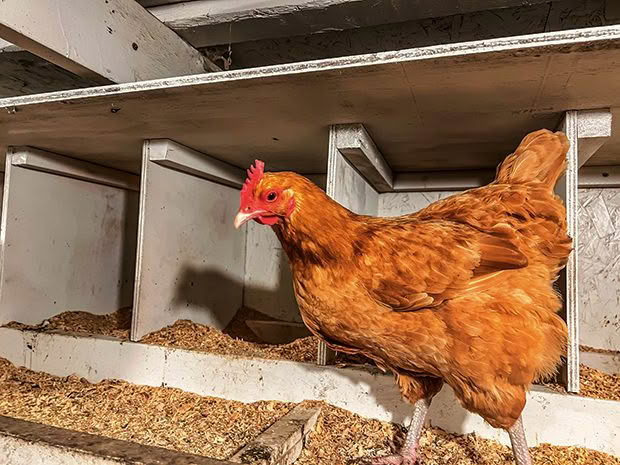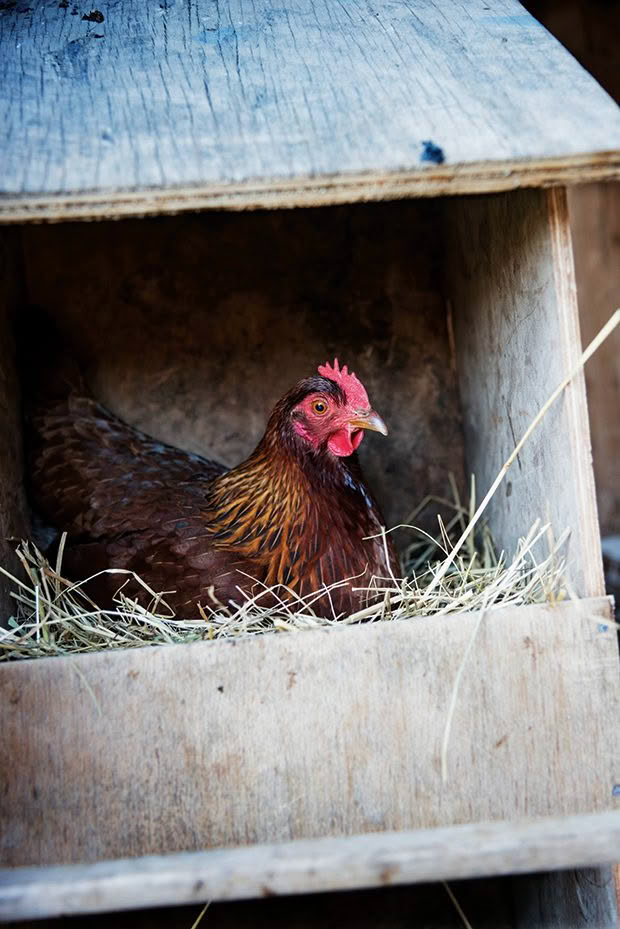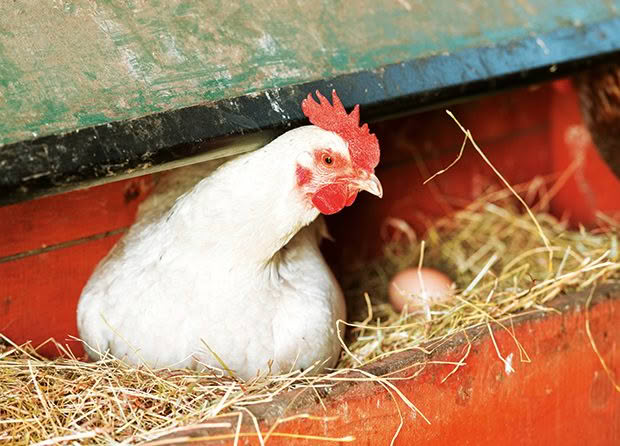Six tips to improve nesting boxes

How you can provide clean, private and safe nesting boxes with plenty of material when your birds get the urge to lay.
Words: Andrea Graves
Despite thousands of years of domestication in safe coops and backyards, chickens still have a strong instinct to lay their eggs in nests. It’s a behaviour that dates back to the modern chicken’s earliest ancestor, the wild junglefowl, which would have needed to build a private, safe nest in the forest to avoid predators and ensure the safety of its eggs. But unlike wild birds that can choose where to build a nest and collect whatever construction materials they want, chickens are limited to what we make available to them. We therefore need to make sure they have everything they need – for their welfare and for us to enjoy clean, unbroken eggs.
1. ENSURE PRIVACY
Without a suitable nest, chickens will still eject their eggs from their bodies: when you gotta go, you gotta go. But it’s still very important to provide them with a nest box for privacy. Konrad Lorenz, one of the first and most famous animal behaviour scientists, documented just how important privacy is to chickens. “The worst torture to which a battery hen is exposed is the inability to retire somewhere for the laying act,” he wrote. “For the person who knows something about animals it is truly heart-rending to watch how a chicken tries again and again to crawl beneath her fellow-cage mates to search there in vain for cover.”
When I was writing my book, I conducted an experiment with my hens and noticed the same thing. Without a nest box, when a hen needed to lay, she would try to hide under her coop mate, ducking her head down between the other’s legs and pushing underneath her over and over again. Eventually she’d give up and sit exposed in a corner to lay. But you don’t need to be an animal behaviour scientist to figure out that something was wrong with that scene.
So privacy matters – and New Zealand laws recognise that. The Layer Hen Code of Welfare, which applies to anyone who keeps laying hens, states that laying birds must have access to a secluded nesting area. Other hens who are also in the process of laying an egg seem to be reasonably welcome bedfellows, but nest boxes should offer privacy overhead and on three sides, preferably with the entry not in full view. Try to have one nest box for every three laying birds and to make them roughly 40cm².
2. PROVIDE PLENTY OF NESTING MATERIAL
When an egg’s on the way, a hen instinctually knows how to make herself a suitable nest. But as she snuggles into her box, she will often grasp nearby material such as dead grass or leaves with her beak and pull it close, placing it in front of her or tossing it to either side of her body. She’ll generally arrange things to her satisfaction before the actual act of laying. The result is a private, soft and rather modest nest to receive her egg.
Chickens don’t need you to create the nest inside the nest box, but they do want soft material that they can arrange into a nest shape with their beaks and bodies. Straw or untreated wood shavings are excellent choices. Research shows that this is preferable to any kind of pre-moulded nest.
Given that they can lay almost daily and share their nest with their flockmates, chickens will keep using the same nest again and again – they don’t have to recreate the nest shape every time. But picking up and tossing nest material seems to be part of the pre-laying ritual that’s baked into these birds.
A hen adopts a squatting position for the actual act of laying, with her rear end off the ground, so the egg literally drops onto the surface below. This softness is therefore useful for us too, because it makes it less likely that eggs will be broken. That’s a good reason to be generous with nesting material. I line the nest box with cardboard or thick paper so that if an egg does break, it’s easier to scoop out the whole lot and put it in the compost bin. Hardened egg innards set like glue. To ensure the material stays put, it’s helpful to create nest boxes with a lip, such as a strip of wood.

3. KEEP NESTING BOXES BELOW PERCHES
Clean, unbroken eggs should be the norm in any nest box. Chickens will not willingly poo in their own nests, unless they’re sleeping in there, because birds are incontinent overnight. If your chickens are sleeping and pooing in their nests, it’s most likely because the nest boxes are higher than the perches, because chickens want to sleep at the highest point. If this happens, you not only have a dirty egg problem but a disease risk due to a pile of faeces and its associated microbial load being in prolonged contact with a warm body. The exception to the rule is a broody hen. She’ll spend almost all day and certainly all night on the nest and yet never defecates in there. She emerges once a day to produce one giant dropping well away from her precious eggs.
4. KEEP NEST BOXES CLEAN
The downside of providing lots of material for your chickens is that it can make a home for other creatures. For years I had a superiority complex about the fact that I’d never encountered mites in the nest box. Then my birds started laying their eggs outside, and a Facebook follower suggested I check for creepy-crawlies. I found one type on the paper under the nesting material (although I had to stand in the sun and put on my glasses to see them), and there were others on the feathers around my birds’ vents. At the base of those feathers I could clearly see dark, dirty-looking clusters of lice eggs, whereas the lice on their skin were well-camouflaged – only their movement caught my eye.
It was time for a purge. I washed out the nest box and even changed to a plastic one for a while. Fresh paper with a light dusting of dog flea powder and new wood shavings made a nice new nesting spot. I used the powder on the birds’ behinds and repeated it again a couple of weeks later. Now I regularly swoop them up for a butt inspection and change the nesting material more often. There’s no way to avoid this problem completely, although replacing loose material with a plastic nest pad is said to help. Under the code of welfare, plastic matting, artificial turf or soft stuff like straw is required for nests, but only to cover wire mesh floors. I wonder how much more plastic the planet can cope with (less than it already has, no doubt), and I strongly suspect that, from the bird’s point of view, it’s an inadequate substitute for loose
nest material.

5. PLACE BOXES AWAY FROM THE EAST-FACING WALL
Another aspect of health is thermal comfort. Nest boxes are usually pleasingly cosy, but in summer they can get too hot. Laying is usually a morning activity, and the sun rises in the east, so it is worth situating nest boxes away from the east-facing wall of the coop. A couple of summers ago my birds protested about their east-facing nest box in our dark grey coop by decamping to a cool, dark nest they made underneath a flax bush. When autumn came they moved back inside. I was impressed at their flexibility, because they do tend to be creatures of habit.
6. SHUT IN NEW LAYERS
A common problem with laying hens is their tendency to pick a different nesting site than the one you’ve selected. For this reason, it’s wise to shut in new layers to where you’d like them to nest. But timing is everything, as I learnt last autumn when I bought some point-of-lay pullets. One started laying earlier than the rest, and that happened around the time she became keen on exploring the neighbour’s property. She had a nest box available to her, but the urge to lay apparently struck while she was next door. She made a sweet little nest under their lounge window, sheltered by a small maple tree. This made the escapes difficult to tackle because her need to lay became fused with her urge to escape. She had to get to the maple every morning. She’d then continue her explorations and apparently lacked any homing instinct, apart from when she saw me. When I eventually found her on the roadside or neighbouring properties, head down and tail up, she’d stand to attention and follow me home. I’ve never known such a brave and independent chicken. After a few days of being fenced in with the nest box, she soon chose to use it.
The reason nests are so important to chickens is the evolutionary baggage these birds carry. To us, eggs are food items. To a hen, unless she’s broody, eggs are pretty uninteresting once they’re laid. But egg-laying and its lead-up are profound physiological processes, and a hen’s instincts at this time remain as strong as if her reproductive success was at stake. She is compelled to find a place that’s soft, warm and safe from predators. Our job, as chicken keepers, is to understand what our birds need – primarily, privacy and soft, loose nesting material – and to provide it.
Love this story? Subscribe now!
 This article first appeared in NZ Lifestyle Block Magazine.
This article first appeared in NZ Lifestyle Block Magazine.
